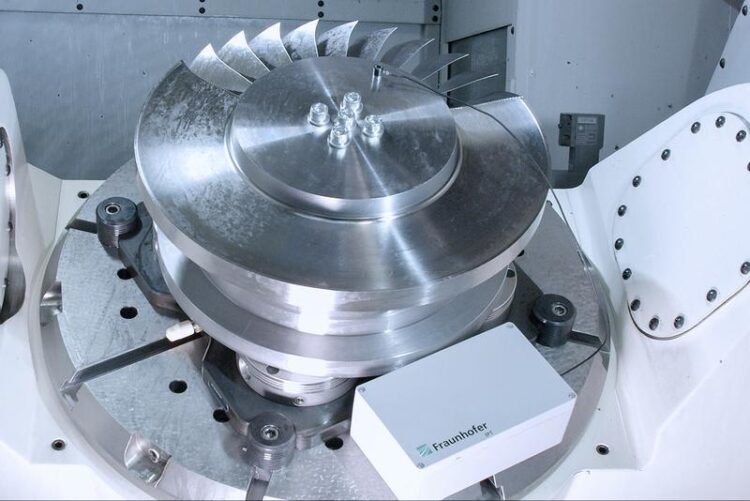5G sensor technology for collision control protects machine tools and components

Collision control using a 5G sensor in machine tool.
Photo: Paperplane Productions / © Fraunhofer IPT
Complex production processes in highly flexible and networked manufacturing systems require all processes and distributed systems to be able to exchange their data extremely reliably and with only short delay times. For this so-called “Ultra Reliable and Low Latency Communication” (URLLC), the 3rd Generation Partnership Project (3GPP), a worldwide cooperation for the standardization of mobile communication technologies, is developing a new standard for future 5G products.
The Fraunhofer-Institute for Production Technology IPT and the Swedish mobile communications supplier Ericsson are now testing the envisaged URLLC functions in Aachen using a real production scenario for collision control in machine tools. Mastering manufacturing processes such as the milling of highly complex components means, above all, quickly detecting deviations in the movement of the tool and reacting to them within a few milliseconds. Machine-integrated sensors can be used to record process data; the new 5G mobile communications standard can ensure that the data obtained is transmitted wirelessly so quickly and reliably, that the machine tool can respond to changes in the process before the component is damaged.
In the collision detection application, which is now being tested in Aachen, a sensor detects the collision of the machining tool with the component so quickly that the machine can be stopped in time at any moment. In this way, sometimes immense damage, for example to the machine spindle, can be reliably avoided without human intervention.
5G test system achieves even higher data rates and lower latencies in the mmWave spectrum
A new modular test system from Ericsson is used to meet the required URLLC specifications. For this purpose, the test system operates in the millimeter wavelength range (mmWave), a new 5G spectrum with frequencies between 24 and 28 gigahertz that can be applied for from the German Federal Network Agency, with immediate effect. While more than 80 companies have secured stationary 5G systems of the 3.7 to 3.8 gigahertz frequency range in Germany, the millimeter wavelength range is so far new and hardly tested in production.
However, the larger spectral range allows even higher data rates and lower latencies than in previous systems, so that particularly time-critical applications such as collision detection can now be implemented.
Collision monitoring in the machine tool serves as a blueprint for other time- and data-critical applications
The new Ericsson test system in the millimeter wavelength range is now being tested and tried by the Fraunhofer IPT in the context of the 5G-Industry Campus Europe. “The extremely latency-critical use case of collision detection in particular provides us with a good opportunity to exploit the potential of the additional frequency range and push industrial manufacturing processes to its limits,” says Jan-Peter Meyer-Kahlen, head of Ericsson’s Eurolab research and development site near Aachen.
“This means that we can now monitor and control processes that were previously technically almost impossible to master due to their complexity. By enabling us to capture and process the enormous volumes of data generated in the milling process within a very short time and feed them back into the machine tool, 5G opens up completely new fields of application for our project partners, ” adds Niels König, coordinator of the 5G-Industry Campus Europe at the Fraunhofer IPT.
5G-Industry Campus Europe: Infrastructure for applied research on connected, adaptive production
Europe’s largest 5G research infrastructure, the 5G-Industry Campus Europe, went online in May 2020. Fraunhofer IPT is researching and testing the first industrial 5G applications together with its research partners in Aachen. A total of seven subprojects are investigating various application scenarios ranging from 5G sensor technology for monitoring and controlling highly complex manufacturing processes to mobile robotics and logistics to production chains spanning multiple locations. In addition, the Aachen scientists are testing the use of modern edge cloud systems for the rapid processing of data in order to exploit the potential of 5G in networked, adaptive production.
The 5G-Industry Campus Europe was set up as part of a research project funded by the German Federal Ministry of Transport and Digital Infrastructure (BMVI) and is directly aimed at introducing the new mobile communications standard in the manufacturing industry.
Interested companies and research partners who would like to find out more can contact the consortium via the project website: www.5G-Industry-Campus.com
Project Consortium
– Fraunhofer Institute for Production Technology IPT, Aachen (project management)
– Research Institute for Rationalization (FIR) e. V. at RWTH Aachen University
– Machine Tool Laboratory WZL of RWTH Aachen University
– IT Centre of RWTH Aachen University
– Ericsson GmbH, Aachen
Wissenschaftliche Ansprechpartner:
Dipl.-Phys. Niels König
Head of department “Production metrology”
Fraunhofer Institute for Production Technology IPT
Steinbachstr. 17
52074 Aachen, Germany
Phone +49 241 8904-113
Niels.Koenig@ipt.fraunhofer.de
www.ipt.fraunhofer.de/en
Weitere Informationen:
https://www.ipt.fraunhofer.de/en/Press/Pressreleases/210119-5g-sensor-technology…
Media Contact
All latest news from the category: Information Technology
Here you can find a summary of innovations in the fields of information and data processing and up-to-date developments on IT equipment and hardware.
This area covers topics such as IT services, IT architectures, IT management and telecommunications.
Newest articles

First-of-its-kind study uses remote sensing to monitor plastic debris in rivers and lakes
Remote sensing creates a cost-effective solution to monitoring plastic pollution. A first-of-its-kind study from researchers at the University of Minnesota Twin Cities shows how remote sensing can help monitor and…

Laser-based artificial neuron mimics nerve cell functions at lightning speed
With a processing speed a billion times faster than nature, chip-based laser neuron could help advance AI tasks such as pattern recognition and sequence prediction. Researchers have developed a laser-based…

Optimising the processing of plastic waste
Just one look in the yellow bin reveals a colourful jumble of different types of plastic. However, the purer and more uniform plastic waste is, the easier it is to…



